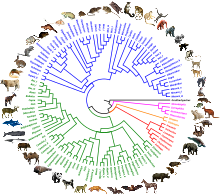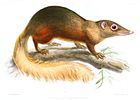| Euarchontoglires Temporal range: Paleocene–Present PreꞒ Ꞓ O S D C P T J K Pg N | |
|---|---|

| |
| From top to bottom (left): rat, treeshrew, colugo; (right) hare, macaque with human. | |
| Scientific classification | |
| Domain: | Eukaryota |
| Kingdom: | Animalia |
| Phylum: | Chordata |
| Class: | Mammalia |
| Magnorder: | Boreoeutheria |
| Superorder: | Euarchontoglires Murphy et al., 2001 |
| Subgroups | |
| |
Euarchontoglires (from: Euarchonta ("true rulers") + Glires ("dormice")), synonymous with Supraprimates, is a clade and a superorder of placental mammals, the living members of which belong to one of the five following groups: rodents, lagomorphs, treeshrews, primates, and colugos.
Evolutionary affinities within mammals

The Euarchontoglires clade is based on DNA sequence analyses and retrotransposon markers that combine the clades Glires (Rodentia + Lagomorpha) and Euarchonta (Scandentia + Primates + Dermoptera). It is usually discussed without a taxonomic rank but has been called a cohort, magnorder, or superorder. Relations among the four cohorts (Euarchontoglires, Xenarthra, Laurasiatheria, Afrotheria) and the identity of the placental root remain controversial.
So far, few, if any, distinctive anatomical features have been recognized that support Euarchontoglires; nor does any strong evidence from anatomy support alternative hypotheses. Although both Euarchontoglires and diprotodont marsupials are documented to possess a vermiform appendix, this feature evolved as a result of convergent evolution.
Euarchontoglires probably split from the Boreoeutheria magnorder about 85 to 95 million years ago, during the Cretaceous, and developed in the Laurasian island group that would later become Europe. This hypothesis is supported by molecular evidence; so far, the earliest known fossils date to the early Paleocene. The combined clade of Euarchontoglires and Laurasiatheria is recognized as Boreoeutheria.
Phylogenetic relationships within the clade
The hypothesized relationship among the Euarchontoglires is as follows:
| Boreoeutheria |
| ||||||||||||||||||||||||||||||
One study based on DNA analysis suggests that Scandentia and Primates are sister clades, but does not discuss the position of Dermoptera. Although it is known that Scandentia is one of the most basal Euarchontoglires clades, the exact phylogenetic position is not yet considered resolved, and it may be a sister of Glires, Primatomorpha or Dermoptera or to all other Euarchontoglires. Some old studies place Scandentia as sister of the Glires, invalidating Euarchonta.
Whole-genome duplication may have taken place in the ancestral Euarchontoglires.
References
- ^ Murphy, William J.; Eizirik, Eduardo; O'Brien, Stephen J.; Madsen, Ole; Scally, Mark; Douady, Christophe J.; Teeling, Emma; Ryder, Oliver A.; Stanhope, Michael J.; de Jong, Wilfried W.; Springer, Mark S. (2001). "Resolution of the early placental mammal radiation using Bayesian phylogenetics". Science. 294 (5550): 2348–2351. Bibcode:2001Sci...294.2348M. doi:10.1126/science.1067179. PMID 11743200. S2CID 34367609.
- Missiaen P, Smith T, Guo DY, Bloch JI, Gingerich PD (2006). "Asian gliriform origin for arctostylopid mammals". Naturwissenschaften. 93 (8): 407–411. Bibcode:2006NW.....93..407M. doi:10.1007/s00114-006-0122-1. hdl:1854/LU-353125. PMID 16865388. S2CID 23315598.
- Scornavacca C, Belkhir K, Lopez J, Dernat R, Delsuc F, Douzery EJ, Ranwez V (April 2019). "OrthoMaM v10: Scaling-up orthologous coding sequence and exon alignments with more than one hundred mammalian genomes". Molecular Biology and Evolution. 36 (4): 861–862. doi:10.1093/molbev/msz015. PMC 6445298. PMID 30698751.
- Asher, RJ; Bennett, N; Lehmann, T (2009). "The new framework for understanding placental mammal evolution". BioEssays. 31 (8): 853–864. doi:10.1002/bies.200900053. PMID 19582725.
- ^ Kumar, Vikas; Hallström, Björn M.; Janke, Axel (2013-04-01). "Coalescent-Based Genome Analyses Resolve the Early Branches of the Euarchontoglires". PLOS ONE. 8 (4): e60019. Bibcode:2013PLoSO...860019K. doi:10.1371/journal.pone.0060019. ISSN 1932-6203. PMC 3613385. PMID 23560065.
- Smith, H. F.; Fisher, R. E.; Everett, M. L.; Thomas, A. D.; Randal-Bollinger, R.; Parker, W. (October 2009). "Comparative anatomy and phylogenetic distribution of the mammalian cecal appendix". Journal of Evolutionary Biology. 22 (10): 1984–1999. doi:10.1111/j.1420-9101.2009.01809.x. PMID 19678866.
- O'Leary, M. A.; Bloch, J. I.; Flynn, J. J.; Gaudin, T. J.; Giallombardo, A.; Giannini, N. P.; Cirranello, A. L. (2013). "The placental mammal ancestor and the post–K-Pg radiation of placentals". Science. 339 (6120): 662–667. Bibcode:2013Sci...339..662O. doi:10.1126/science.1229237. hdl:11336/7302. PMID 23393258. S2CID 206544776.
- Esselstyn, Jacob A.; Oliveros, Carl H.; Swanson, Mark T.; Faircloth, Brant C. (2017-08-26). "Investigating Difficult Nodes in the Placental Mammal Tree with Expanded Taxon Sampling and Thousands of Ultraconserved Elements". Genome Biology and Evolution. 9 (9): 2308–2321. doi:10.1093/gbe/evx168. PMC 5604124. PMID 28934378.
- Song S, Liu L, Edwards SV, Wu S (2012). "Resolving conflict in eutherian mammal phylogeny using phylogenomics and the multispecies coalescent model". Proceedings of the National Academy of Sciences. 109 (37): 14942–7. Bibcode:2012PNAS..10914942S. doi:10.1073/pnas.1211733109. PMC 3443116. PMID 22930817.
- Foley, Nicole M.; Springer, Mark S.; Teeling, Emma C. (2016-07-19). "Mammal madness: Is the mammal tree of life not yet resolved?". Philosophical Transactions of the Royal Society B. 371 (1699): 20150140. doi:10.1098/rstb.2015.0140. ISSN 0962-8436. PMC 4920340. PMID 27325836.
- Zhou, Xuming; Sun, Fengming; Xu, Shixia; Yang, Guang; Li, Ming (2015-03-01). "The position of tree shrews in the mammalian tree: Comparing multi-gene analyses with phylogenomic results leaves monophyly of Euarchonta doubtful". Integrative Zoology. 10 (2): 186–198. doi:10.1111/1749-4877.12116. ISSN 1749-4877. PMID 25311886.
- Meredith, Robert W.; Janečka, Jan E.; Gatesy, John; Ryder, Oliver A.; Fisher, Colleen A.; Teeling, Emma C.; Goodbla, Alisha; Eizirik, Eduardo; Simão, Taiz L. L. (2011-10-28). "Impacts of the Cretaceous terrestrial revolution and KPg extinction on mammal diversification". Science. 334 (6055): 521–524. Bibcode:2011Sci...334..521M. doi:10.1126/science.1211028. ISSN 0036-8075. PMID 21940861. S2CID 38120449.
- Zhou, Xuming; Sun, Fengming; Xu, Shixia; Yang, Guang; Li, Ming (2015-03-01). "The position of tree shrews in the mammalian tree: Comparing multi-gene analyses with phylogenomic results leaves monophyly of Euarchonta doubtful". Integrative Zoology. 10 (2): 186–198. doi:10.1111/1749-4877.12116. ISSN 1749-4877. PMID 25311886.
- Dehal, Paramvir; Boore, Jeffrey L. (2005-09-06). "Two Rounds of Whole Genome Duplication in the Ancestral Vertebrate". PLOS Biology. 3 (10): e314. doi:10.1371/journal.pbio.0030314. ISSN 1545-7885. PMC 1197285. PMID 16128622.
Further reading
- Churakov, G.; Kriegs, J. O.; Baertsch, R.; Zemann, A.; Brosius, J. R.; Schmitz, J. R. (2009). "Mosaic retroposon insertion patterns in placental mammals". Genome Research. 19 (5): 868–875. doi:10.1101/gr.090647.108. PMC 2675975. PMID 19261842.
- Goloboff, Pablo A.; Catalano, Santiago A.; Mirande, J. Marcos; Szumik, Claudia A.; Arias, J. Salvador; Källersjö, Mari; Farris, James S. (2009). "Phylogenetic analysis of 73 060 taxa corroborates major eukaryotic groups". Cladistics. 25 (3): 211–230. doi:10.1111/j.1096-0031.2009.00255.x. hdl:11336/78055. PMID 34879616.
- Nikolaev, Sergey; Montoya-Burgos, Juan I.; Margulies, Elliott H.; NISC Comparative Sequencing Program; Rougemont, Jacques; Nyffeler, Bruno; Antonarakis, Stylianos E. (2007). "Early History of Mammals is Elucidated with the ENCODE Multiple Species Sequencing Data". PLoS Genetics. 3 (1): e2. doi:10.1371/journal.pgen.0030002. PMC 1761045. PMID 17206863.
- Springer, Mark S.; Murphy, William J.; Eizirik, Eduardo; O'Brien, Stephen J. (2003). "Placental mammal diversification and the Cretaceous–Tertiary boundary". Proceedings of the National Academy of Sciences. 100 (3): 1056–1061. Bibcode:2003PNAS..100.1056S. doi:10.1073/pnas.0334222100. PMC 298725. PMID 12552136.
- Waddell, Peter J.; Kishino, Hirohisa; Ota, Rissa (2001). "A phylogenetic foundation for comparative mammalian genomics". Genome Informatics. 12: 141–154. PMID 11791233. Archived from the original on 2019-07-10. Retrieved 2015-08-27.
- Wildman, Derek E.; Chen, Caoyi; Erez, Offer; Grossman, Lawrence I.; Goodman, Morris; Romero, Roberto (2006). "Evolution of the mammalian placenta revealed by phylogenetic analysis". Proceedings of the National Academy of Sciences. 103 (9): 3203–3208. Bibcode:2006PNAS..103.3203W. doi:10.1073/pnas.0511344103. PMC 1413940. PMID 16492730.
| Extant mammal orders | |||||||||||||||||||||
|---|---|---|---|---|---|---|---|---|---|---|---|---|---|---|---|---|---|---|---|---|---|
| |||||||||||||||||||||
| Yinotheria |
| ||||||||||||||||||||
| Theria |
| ||||||||||||||||||||
| Euarchontoglires | |||||||||||||||||||||||||||||||||||||||||
|---|---|---|---|---|---|---|---|---|---|---|---|---|---|---|---|---|---|---|---|---|---|---|---|---|---|---|---|---|---|---|---|---|---|---|---|---|---|---|---|---|---|
| |||||||||||||||||||||||||||||||||||||||||
| |||||||||||||||||||||||||||||||||||||||||
| |||||||||||||||||||||||||||||||||||||||||
| Taxon identifiers | |
|---|---|
| Euarchontoglires | |




